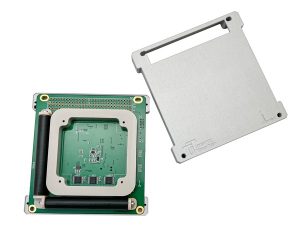A magnetorquer CubeSat is a small satellite that uses magnetorquers—devices that create torque through interaction with Earth’s magnetic field—to control its attitude or orientation in space. Magnetorquers are part of a larger attitude control system (ACS) and offer a fuel-free, energy-efficient method of adjusting the satellite’s position.

In contrast to traditional propulsion-based systems, magnetorquers offer a lighter, simpler, and more cost-effective solution for CubeSats, which are typically used for small-scale missions. These systems work by generating a magnetic moment in the satellite, creating torque that interacts with Earth’s magnetic field to rotate and stabilize the satellite.
How Do Magnetorquer CubeSats Work?
1. Magnetic Torque Generation
The core function of a magnetorquer CubeSat is to generate a magnetic moment by using electromagnetic coils or magnetorquer rods placed on the satellite. When electric current passes through these coils, a magnetic field is created. This magnetic field interacts with the Earth’s geomagnetic field, producing a torque that alters the orientation of the CubeSat.
By adjusting the current flowing through the coils, the CubeSat can control its pitch, yaw, and roll, enabling precise attitude adjustments without the need for fuel or thrusters. This feature makes magnetorquers especially valuable in long-term space missions where fuel conservation is critical.
2. Orientation Control via Magnetic Field Interaction
The efficiency of magnetorquers depends largely on the strength of the Earth’s magnetic field. Most CubeSats in low Earth orbit (LEO) take advantage of this natural resource to maintain their orientation with minimal power consumption. Since the Earth’s magnetic field is omnipresent, magnetorquer systems can operate continuously, making them a reliable and sustainable choice for small satellite operations.
Advantages of Magnetorquer CubeSats
1. Lightweight and Compact Design
Magnetorquer CubeSats are significantly smaller and lighter compared to traditional propulsion-based systems. This reduction in size allows for more payload capacity, which is essential for CubeSats, as they are designed for specific missions like Earth observation, scientific research, and communication.
The compact design also means that CubeSats using magnetorquers can be launched as part of larger constellations, where multiple small satellites work together to accomplish a collective goal.
2. Fuel-Free Operation
Unlike conventional satellite attitude control systems, magnetorquers do not require fuel for their operation. This fuel-free nature reduces the overall mass of the satellite, extending mission duration and minimizing operational costs. CubeSats equipped with magnetorquers can operate for extended periods, even years, without the need for fuel replenishment.
3. Energy Efficiency
Magnetorquers are highly energy-efficient. Since they rely on the Earth’s magnetic field rather than active propulsion, they consume very little power. The low power requirement makes them ideal for small satellites that have limited energy resources, such as those powered by solar panels and batteries.
Applications of Magnetorquer CubeSats
1. Scientific Research and Earth Observation
Magnetorquer CubeSats are frequently used in scientific missions, including Earth observation, climate monitoring, and space research. Their ability to precisely control orientation makes them suitable for instruments such as cameras, sensors, and telescopes that require stable pointing in specific directions.
For example, a CubeSat equipped with a magnetorquer system could be used to monitor deforestation, track ocean temperatures, or study atmospheric conditions, all while maintaining a steady and accurate orientation.
2. Satellite Constellations for Communication
In communication networks, CubeSats with magnetorquers are part of satellite constellations that enable global communication systems. Magnetorquers help maintain the alignment of these small satellites, ensuring that communication links remain intact across large areas.
These constellations, such as those for Internet of Things (IoT) connectivity or global broadband, depend on precise satellite positioning to provide seamless coverage and connectivity.
3. Space Exploration Missions
Magnetorquer CubeSats are also used in space exploration, where stability and orientation control are crucial. For example, CubeSats launched for interplanetary missions or asteroid exploration use magnetorquers to maintain their orientation relative to distant targets or spacecraft.
Challenges of Using Magnetorquer CubeSats
1. Dependence on Geomagnetic Field Strength
The effectiveness of magnetorquer systems is dependent on the strength of the Earth’s magnetic field, which is strongest at lower altitudes in low Earth orbit. As a result, CubeSats operating outside of LEO may face challenges in utilizing magnetorquers efficiently. Higher orbits or deep space missions may require additional or hybrid attitude control systems.
2. Magnetic Interference
In some cases, the presence of magnetic fields from other spacecraft, the Sun, or space debris can interfere with the magnetorquer system’s performance. This can be mitigated with careful mission planning and by incorporating additional systems such as reaction wheels or control moment gyroscopes for backup control.
3. Limited Torque Generation
While magnetorquers are effective for small adjustments in attitude, they may struggle to provide large-scale changes in orientation, especially for heavier satellites or those with more complex mission requirements. For larger adjustments, alternative control systems may be necessary.
The Future of Magnetorquer CubeSats
As satellite technology continues to advance, magnetorquer CubeSats are becoming a more prominent solution for attitude control in small satellites. Research and development into more efficient magnetorquer designs, combined with other satellite control technologies, will likely expand their capabilities and applications in the coming years.
Explore More About Satellite Control Technologies
Want to learn more about how magnetorquers fit into satellite systems? Click here to explore advanced satellite control technologies and their evolving role in space missions.
